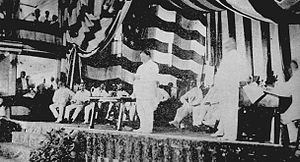User:Ldavs/sandbox

The Philippine Assembly was the lower house of the legislative body of the Philippines during the early part of the American colonial period. It was pledged to Filipinos by the Americans in the Philippine Organic Act of 1902, which also established the Philippine Commission as the upper house of the Philippine Legislature, headed by the Governor-General. The Assembly was formally established on July 30, 1907. Sergio Osmeña was appointed Speaker of the Assembly, with Manuel L. Quezon and Vicente Singson representing the majority and minority floor leaders, respectively.[1] The creation of the Assembly was the first step towards Philippine autonomy and a self-sufficient government.
Background[edit]
American Colonization[edit]
The Philippines fell under the control of Spain in 1521, over 300 years before the Spanish-American War. When the United States began to show interest in the Philippines, it was in the midst of a revolution against its colonizers. The Philippine Revolution (known to Spaniards as the Tagalog War) began when Spanish authorities discovered the Katipunan rebel group in August 1896. In May 1898, America intervened by attacking Spanish fleets at Manila Bay, returning Emilio Aguinaldo from exile, and allying with the Filipino rebels. The Philippines declared its independence from Spain on June 12, 1898. After the defeat of the Spanish troops in 1898, the war was called to an official end at the Treaty of Paris. Here Spain handed over many of its colonies to the United States, including Cuba, Puerto Rico, and the Philippines, which was sold for 20 million dollars.[2] The Americans began their colonization of the Philippines in 1899, and after a failed battle for independence, civil government was established in 1901.[3] The Philippines would not be completely free of American rule until 1946.[2]
Creation of the Assembly[edit]
As a result of the Philippine Organic Act (also known as the Cooper Act), the Philippine Commission conducted a census in 1903, which was published on March 25, 1905.[4] The United States government promised its colony that two years after the census' publication, they would create the Philippine Assembly, a group of elected Filipino officials who would participate in legislative decisions. When the act was passed in 1902, the appointed Governor-General to the Philippines, William Howard Taft, envisioned that the Assembly would improve Philippine-American relations, and prepare the Filipinos for eventual self-rule. President Roosevelt hesitated to grant the Philippines greater authority, however, and viewed the Assembly as more of an experiment rather than a true step toward Philippine autonomy.[5] Regardless, when the Philippine Commission reported in 1907 that the two-year waiting period had passed peacefully, Roosevelt allowed 1904 Governor-General Luke Wright to call for the Assembly's formation. On July 30, 1907, the first national elections were held for the Assembly.[4]
Although several parties and independents vied for positions in the Assembly, two political groups in particular—the Partido Nacionalista and Partido Nacional Progresista—dominated the proceedings. The Nacionalista Party, which espoused "immediate and complete independence," and was headed by future Vice President/President Sergio Osmeña, captured majority of the 80-seat Assembly.[6] On October 16, 1907, the Philippine Assembly was inaugurated at the Manila Grand Opera House.[4] The event was attended both by Taft (at this time appointed Secretary of War), and the new Governor-General James Smith. After its inauguration, the Assembly convened and was led by Osmeña and Manuel L. Quezon, later to become the Vice President and President, respectively, of the new Filipino Commonwealth government in 1935. Upon the creation of the Assembly, Philippine legislature was to take after the model of the U.S. House of Representatives.[1]
The Assembly was to become the lower house of Philippine legislation. The Philippine Commission, formerly the only legislative authority, was appointed the upper house.[7] Throughout the Assembly's history, there was conflict in the legislature between the elected Assembly (composed entirely of Filipinos) and the appointed Commission (made up of mostly American authorities). This period came to an end when the Jones Law was passed, and on October 16, 1916, a bicameral legislature composed exclusively of Filipinos was established.[8] This brought the Filipinos closer to the attainment of an efficient, independent Philippine government.
See also[edit]
- Senate of the Philippines
- House of Representatives of the Philippines
- History of the Philippines (1898-1946)
References[edit]
- ^ a b http://www.nhcp.gov.ph/index.php?option=com_content&task=view&id=14
- ^ a b http://historywired.si.edu/detail.cfm?ID=171
- ^ http://www5b.biglobe.ne.jp/~korea-su/korea-su/e.korea/korea-problem/The_American_governance_of_the_Philippines.html
- ^ a b c "The History of the First Philippine Assembly (1907-1916)". Official Website. National Historical Commission of the Philippines. Retrieved 18 December 2011.
- ^ Wertheim, Stephen (September 2009). "Reluctant Liberator: Theodore Roosevelt's Philosophy of Self-Government and Preparation for Philippine Independence". Presidential Studies Quarterly. 39 (3): 494–518. doi:10.1111/j.1741-5705.2009.03688.x. Retrieved 2 April 2013.
{{cite journal}}: CS1 maint: date and year (link) - ^ Philippine House of Representatives elections, 1916
- ^ Robertson, James Alexander (July 1917). "The Philippines since the Inauguration of the Philippine Assembly". The American Historical Review. 22 (4): 811–830. doi:10.2307/1836242. JSTOR 1836242. Retrieved 2 April 2013.
{{cite journal}}: CS1 maint: date and year (link) - ^ Zaide 1994, pp. 285–286
Sources[edit]
- Zaide, Sonia M. (1994), The Philippines: A Unique Nation, All-Nations Publishing Co., ISBN 971-642-071-4
External links[edit]
- Senate of the Philippines
- House of Representatives of the Philippines
- Philippine Assembly An article published in an American newspaper examining the membership and accoomplishments of the Philippine Assembly during the early years of American rule. An online article made available by Filipiniana.net
- Philippine Bill of 1902 A US Congress Act establishing the Philippine Assembly. An online article made available by Filipiniana.net
Category:American colonial period of the Philippines Category:Legislatures of the Philippines Philippines Category:Dependency legislatures
